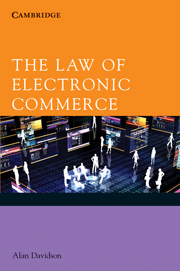Book contents
- Frontmatter
- Contents
- Acknowledgements
- Table of Cases
- Table of statutes
- 1 The law of electronic commerce
- 2 The rule of cyberspace
- 3 Electronic commerce and the law of contract
- 4 Shrinkwrap, clickwrap and browsewrap contracts
- 5 Electronic signatures
- 6 Copyright issues in electronic commerce
- 7 Electronic commerce – trade marks, patents and circuit layouts
- 8 Domain names
- 9 Domain name disputes
- 10 Uniform domain name dispute resolution policies
- 11 Jurisdiction in cyberspace
- 12 Defamation in cyberspace
- 13 Privacy and data protection in cyberspace
- 14 Electronic mail and online presence
- 15 National electronic surveillance
- 16 Cybercrime
- 17 Evidence of electronic records
- 18 Censorship – Broadcast and online content regulation
- 19 An international perspective
- Appendix A Electronic Transactions (Victoria) Act 2000
- Appendix B UNCITRAL Model Law on Electronic Commerce
- Appendix C Selected provisions Copyright Act 1968 (Cth)
- Appendix D ICANN Uniform Dispute Resolution Policy (UDRP)
- Appendix E .au Dispute Resolution Policy (auDRP)
- Appendix F National Privacy Principles
- Index
- References
3 - Electronic commerce and the law of contract
Published online by Cambridge University Press: 05 June 2012
- Frontmatter
- Contents
- Acknowledgements
- Table of Cases
- Table of statutes
- 1 The law of electronic commerce
- 2 The rule of cyberspace
- 3 Electronic commerce and the law of contract
- 4 Shrinkwrap, clickwrap and browsewrap contracts
- 5 Electronic signatures
- 6 Copyright issues in electronic commerce
- 7 Electronic commerce – trade marks, patents and circuit layouts
- 8 Domain names
- 9 Domain name disputes
- 10 Uniform domain name dispute resolution policies
- 11 Jurisdiction in cyberspace
- 12 Defamation in cyberspace
- 13 Privacy and data protection in cyberspace
- 14 Electronic mail and online presence
- 15 National electronic surveillance
- 16 Cybercrime
- 17 Evidence of electronic records
- 18 Censorship – Broadcast and online content regulation
- 19 An international perspective
- Appendix A Electronic Transactions (Victoria) Act 2000
- Appendix B UNCITRAL Model Law on Electronic Commerce
- Appendix C Selected provisions Copyright Act 1968 (Cth)
- Appendix D ICANN Uniform Dispute Resolution Policy (UDRP)
- Appendix E .au Dispute Resolution Policy (auDRP)
- Appendix F National Privacy Principles
- Index
- References
Summary
Commerce is typically about profit. The history and development of commerce involves the element of risk. Risk assessment in commerce involves consideration of such factors as the law of contracts, the parties, the goods or services and legal forum. Many commercial parties have braved the new electronic commerce world without knowing or understanding the legal implications.
In an attempt to ensure confidence, many international organisations have proposed treaties, model laws and protocols to encourage certainty and stability for these international electronic commercial practices and in relation to laws of contract. The UNCITRAL Model Law of Electronic Commerce (Model Law) has proved the most popular, with significant international acceptance by national legislatures, including Australia and New Zealand.
This chapter addresses the regulation of, and legislative responses to, electronic contracting. It challenges the wisdom of and necessity for legislation based on the Model Law, and the introduction of the concept of consent as a precondition for the application of selected legislative provisions.
UNCITRAL Model Law of Electronic Commerce
In 1996 the UN Commission on International Law Trade (UNCITRAL) released what is now the most popular model for consumer and commercial protection in an electronic environment. The UNCITRAL Model Law on Electronic Commerce (Model Law) was intended to provide national legislatures with a template of internationally acceptable rules that would remove legal obstacles and create a more secure legal environment for electronic commerce.
- Type
- Chapter
- Information
- The Law of Electronic Commerce , pp. 25 - 65Publisher: Cambridge University PressPrint publication year: 2009



